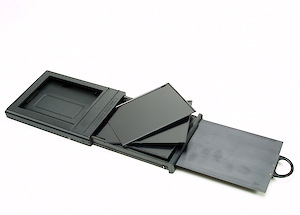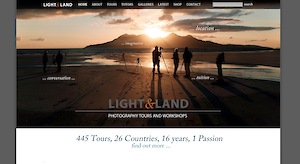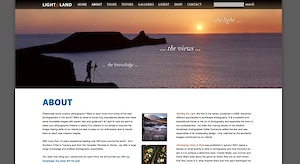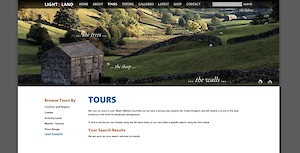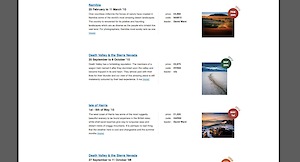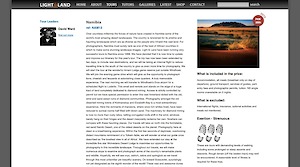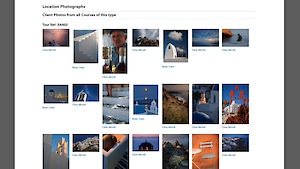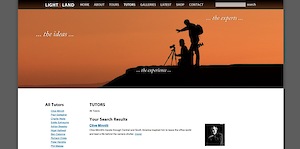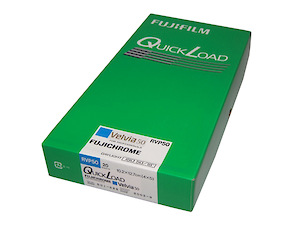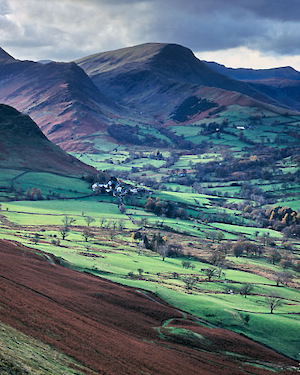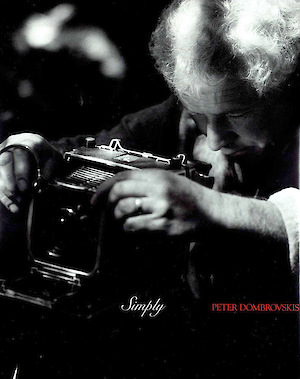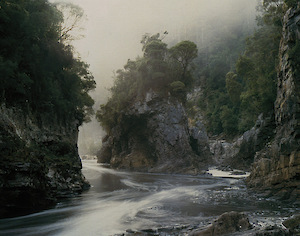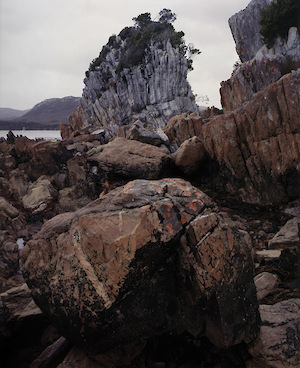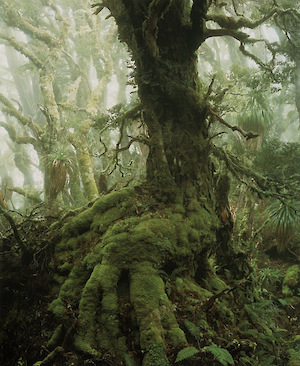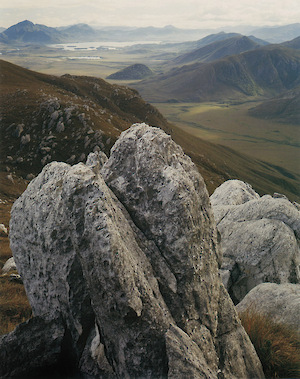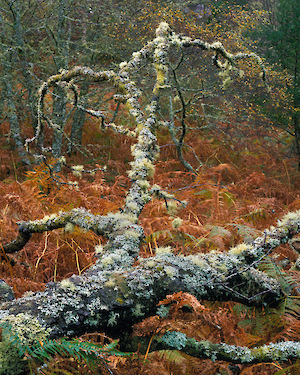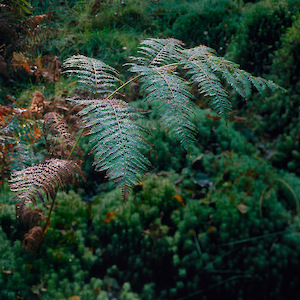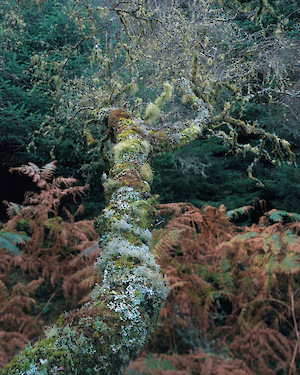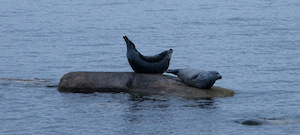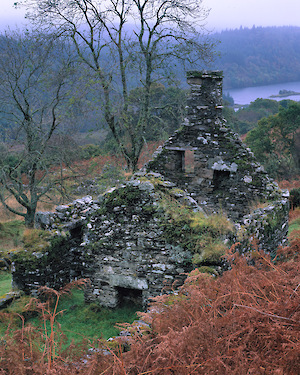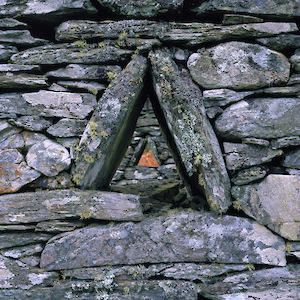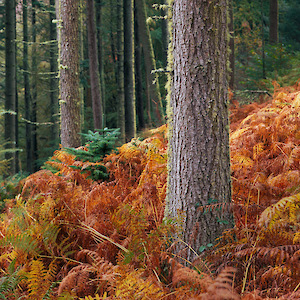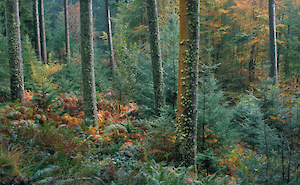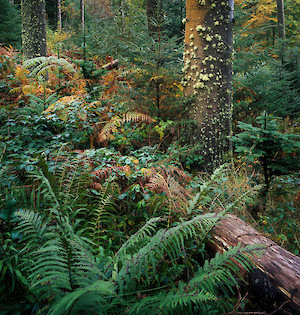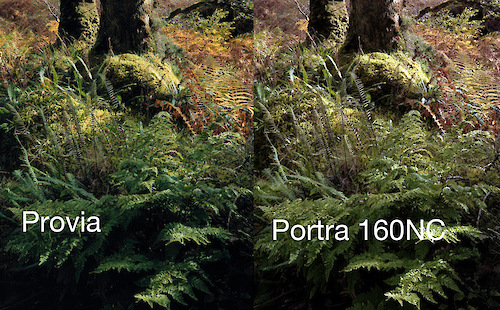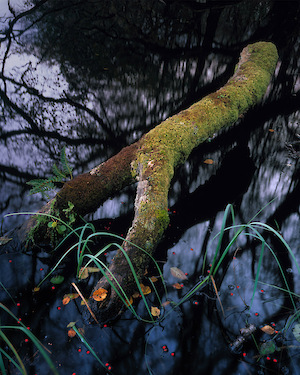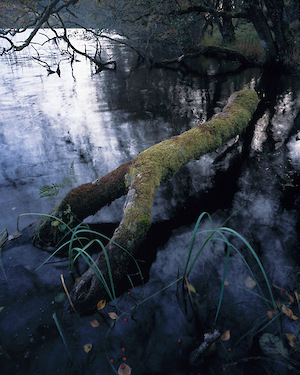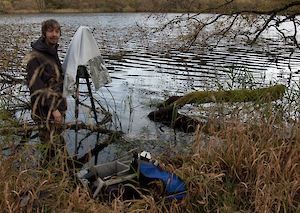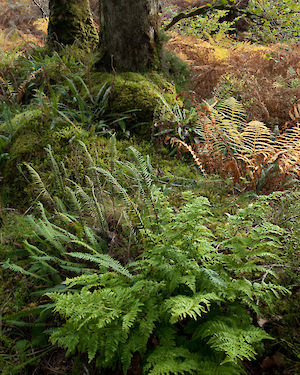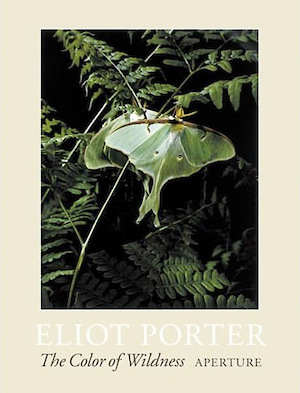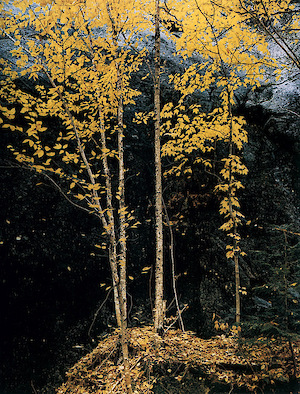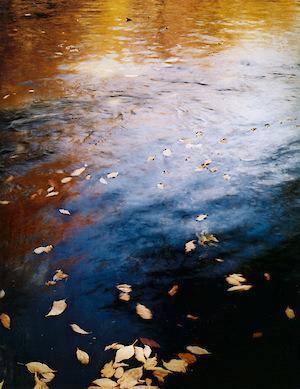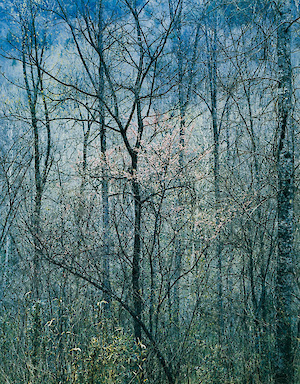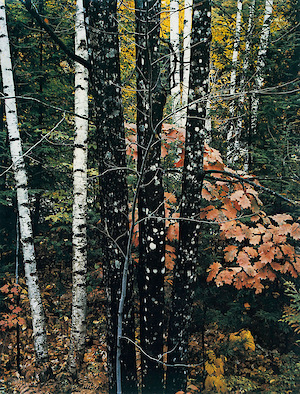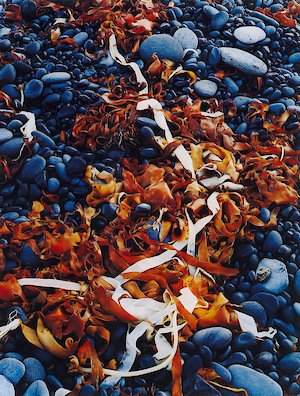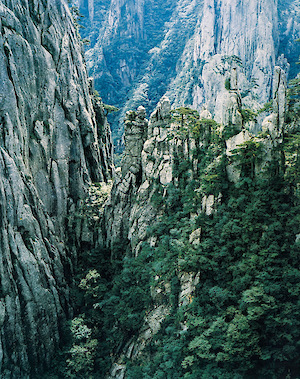For the last couple of years, we’ve met up with Richard Childs on our Scottish holiday and this time he was going to come and stay and bring some developing equipment over. I wanted to find somewhere interesting to take him and the walk at Barnluasgan seemed to fit all the criteria. It’s a ridge line near the Barnluasgan lochan about 100ft up from the road. The area has lots of bracken, birch and old growth oak and looks over the Knapdale forest, a beautiful view of autumnal colour. I had taken a picture the day before (1), just after a torrential downpour which improved the shot enormously, turning the bracken a wonderful rich russet colour. One of my goals in the photograph was to capture the halo of leaves from one of the trees in the background so that it looked like it was decorating the dead branches and the colour of the bracken fading into the dark greens of the top of the picture.
Richard was equally impressed with the place and although it was annoyingly sunny, there was still a substantial amount of material in shade or semi-shade to play with. I caught the early sun on a fern (2) and played around with narrow depth of field combined with tilt to try to emphasize the detail of the fern and the reflections of the sun. I’m still unsure about the results, I don’t think the fern stands out enough from the background (which is possibly because by the time I’d set it up, the light had illuminated the background a little too much).
Me and Richard split up for a while, looking for compositions and I went off purposely looking for a great example of the lichens on the trees around this area. I should have realised before I did so that looking for subject matter isn’t the same as looking for photographic compositions. It is very rare that I get a great picture when I’m actually looking for some subject or other. In this particular instance, I found a suitable tree, found a nice background to take it against and worked hard to get some form of composition that would work with it. There must be something in the way we perceive things that changes when we are looking for something specific. Our mind seems to switch out of ‘abstract perception’ mode and switches into ‘cool subject’ mode. Even though I thought I’d captured a great example of what I was looking for (3), I couldn’t see the fact (or didn’t want to see) that the picture didn’t hang together compositionally. Note to self, look for compositions not subjects – in fact, possibly don’t even think about looking – actively absorb your surroundings!
Anyway – Charlotte left us ‘boy’s to play and we took a couple more pictures and then drove over to Kilberry to see what we could find.. In the end we struggled to ‘get creative’ – the light was pretty flat but we did do some interesting scouting and had a lot of fun just being out of doors. One of the highlights was just standing on the Kiberry shoreline watching the seals perform for us about 200 feet away (see picture, 4). I’ve posted previously about Richard showing me how to develop E6 film in the kitchen of our flat (my thanks got to Richard again – I’ve saved over £150 so far in developing) so we’ll skip to the next day where Richard took us to Arrochonan, a deserted township from the 17th century.
This place was awesome and although we had a dense mist, you could see down to Caol Scotnish and Loch Sween. Looking at the beautiful setting, it’s difficult to think of the hurt that the English brought to the Scottish during the clearances (admittedly because the Scottish clan leaders sold off their own tenants land). When I’m confronted with a large area like this (8 or 9 derelict stone houses distributed up the slope of a hill with an incredible view, I can’t help but want to capture the scale of the location. Each individual house is impressive but the feel of the location is all about the ‘township’. I tried for some time to work out how to acheive this and just couldn’t manage to incorporate this feeling. After a while, I backed to trying to capture the individual parts of the township, none of which were particularly successful but I’ve included a shot the main house (5) (an English built house for the Shepherd, made from the stones of some of the Scottish houses). I’ve shown a comparison of this captured on velvia and astia.
The one shot I am happy with was a detail of one of the windows in the old cottages (6). The windows were of a simplified, triangular lintel free construction (very clever) and were handily situated at the same point on either side of the cottage and when lined up, showed a loveley section of bracken and luckily, the window lined up with the top of the bracken so it wasn’t just an orange triangle. I love the simplicity of this; the beauty that human craft and nature have created giving me the perfect raw materials.
On the way back from the township, we passed the most wonderful area of open pine forest backed by birth. We stopped for a quick picture but I couldn’t resist returning the next day to investigate further and, luckily, the light was good; luminous even. The previous day we had some form of strange green light (both me and Richard got results that had a significant green cast over them) but the next day the light was translucent, even if it was still incredibly humid.
I took 12 sheets of film around this one area, the best two I’ve included on the right hand side. Taking pictures in woodland is difficult but there are a few ways to aid visualisation when doing so. The first, and most important, is to close one eye… second is to open your eye again before you start walking around (can be very embarrasing otherwise). What closing one eye does is remove any of the 3D shapes you can see, collapsing the scene into the two dimensions that you will see on paper. When you’ve found a potential composition. Try and remain still for a while (movement gives you a lot of information of the third dimension that can create shapes that won’t exist in a photograph). A few of ‘friends’ when you are working in the woods are fog, rain, dark backgrounds and low depth of field. All of these are trying to simlify the background so that you don’t get the an overly complex ‘mess’ of branches, etc. (Unless you actually want this complexity – which is a possibility, see Mr Porter)
My three composition reflect very different views of the small patch of forest I was in (I only moved my camera about 20 yards in between them).
The first (7) is a straight on portrait shot taken at the last minute (“it will only take five minutes! Honest Charlotte!”) and literally jumped out at me. The contrast of the bracken against the deep green of the forest behind was wonderful. With added interest in the small fir tree and the small patch of red bracken showing through in the very background, not to mention the limning of the tree in a bright pastel green, this had the quick impact and the longer lasting detail to keep attention. The only post processing here was to tone down the highlights along the stalks of the bracken in the foreground left area.
The second (8) is what might be called a group portrait; An almost formal arrangement of sparesely populated forest where each tree has it’s own space, all set against a backdrop of fir and well-turned beech. The ground was a wonderful colour-blast mix of all shades of bracken, blue green newly grown fir and cyanic green bracken. It’s the single tree in the foreground with the orange lichen that is the feature of the photograph though. I set it so close as to almost be unconfortable, it’s almost the gang leader of this group of trees.
The final picture (9) is one I’m not sure about again. I like it but the composition doesn’t feel balanced to me, it seems twisted somehow, some way I can’t quite put my finger on. I like the look of it at first glance but as I look longer it doesn’t hold together. Any comments on this one?
Click to view full post including 6 Comments
 )
)
